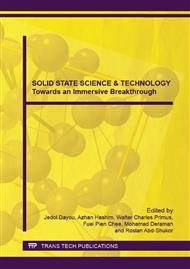[1]
M. Farbod and M. Khademalrasool, Synthesis of TiO2 nanoparticles by a combined sol–gel ball milling method and investigation of nanoparticle size effect on their photocatalytic activities, Powder Technol, 214(3)(2011) 344–348.
DOI: 10.1016/j.powtec.2011.08.026
Google Scholar
[2]
N. R. Mathews, E. R. Morales, M. Cortés-Jacome, and J. Toledo Antonio, TiO2 thin films – Influence of annealing temperature on structural, optical and photocatalytic properties, Sol. Energy, 83(9)(2009) 1499-1508.
DOI: 10.1016/j.solener.2009.04.008
Google Scholar
[3]
M. N. Rashed, Photocatalytic degradation of methyl orange in aqueous TiO2 under different solar irradiation sources, 2(3)(2007) 73-81.
Google Scholar
[4]
S. Paul and A. Choudhury, Investigation of the optical property and photocatalytic activity of mixed phase nanocrystalline titania, Appl. Nanosci, (2013).
DOI: 10.1007/s13204-013-0264-3
Google Scholar
[5]
L. Pe. Bitao Liu, Facial formation of mixed phase porous TiO2 nanotubes and enhanced visible-light photocatalytic activity, J. Alloys Compd. (2013) 145–152.
DOI: 10.1016/j.jallcom.2013.03.221
Google Scholar
[6]
N. T. B. Linh, K. -H. Lee, and B. -T. Lee, Fabrication of photocatalytic PVA–TiO2 nano-fibrous hybrid membrane using the electro-spinning method, J. Mater. Sci. 46(17)(2011) 5615-5620.
DOI: 10.1007/s10853-011-5511-y
Google Scholar
[7]
P. Lei, F. Wang, X. Gao, Y. Ding, S. Zhang, J. Zhao, S. Liu, and M. Yang, Immobilization of TiO2 nanoparticles in polymeric substrates by chemical bonding for multi-cycle photodegradation of organic pollutants, J. Hazard. Mater. (227-228)(2012).
DOI: 10.1016/j.jhazmat.2012.05.029
Google Scholar
[8]
C. D. Nechifor, C. L. Ciobanu, D. -O. Dorohoi, and C. Ciobanu, Polymeric Films Properties Of Poly (Vinyl Alcohol) and Poly (Hydroxy Urethane) in Different Concentrations, 71(2009).
Google Scholar
[9]
Nadras Othman, Nur Azleen Azahari, Hanafi Ismail, Thermal Properties of Polyvinyl Alcohol (PVOH)/Corn Starch Blend Film, M. P. Journal. 6(6)(2011) 147-154.
Google Scholar
[10]
K. Nakane and N. Ogata, Photocatalyst Nanofibers Obtained by Calcination of Organic-Inorganic Hybrids, (2010).
DOI: 10.5772/8155
Google Scholar
[11]
C. Sung, J. Ho, D. Kim, S. Cho, and W. Oh, Processing Research Reaction morphology and the effect of pH on the preparation of TiO2 nanoparticles by a sol-gel method, 11(6)(2010) 736-741.
Google Scholar
[12]
M. A. Ameen and A. J. Khadum, Annealing Effect on the phase Transformation in Sol-Gel Derived Titania Nanostructure, 8(2) (2011).
Google Scholar
[13]
K. Thangavelu, R. Annamalai, and D. Arulnandhi, Synthesis and characterization of nanosized TiO2 powder derived from a sol gel process in acidic condition, Int. J. Eng. Sci. Emerg. Technol. 4(2)(2013) 90-95.
Google Scholar
[14]
R. A. Spurr and H. Myers, Quantitative Analysis of Anatase-Rutile Mixtures with an X-Ray Diffractometer, Anal. Chem. 29(5)(1957) 760-762.
DOI: 10.1021/ac60125a006
Google Scholar
[15]
W. Zhang, B. Yang, and Z. J. Daimei Chen, Effects of calcination temperature on preparation of Boron-doped TiO2 by sol gel method, Int. J. Photoenergy, (2012) 1-8.
DOI: 10.1155/2012/528637
Google Scholar
[16]
K. V. Baiju, Zachariah, S. Shukla, S. Biju, M. L. P. Reddy, and K. G. K. Warrier, Correlating photoluminescence and photocatalytic activity of mixed-phase nanocrystalline titania, Catal. Letters, 130(1-2)(2008) 130-136.
DOI: 10.1007/s10562-008-9798-5
Google Scholar


